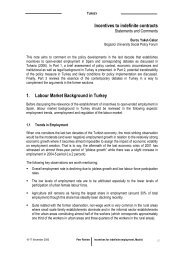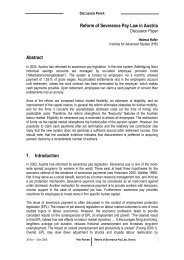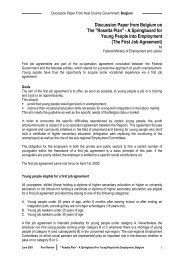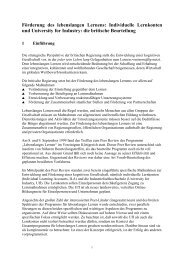Comprehensive strategies for active ageing - mutual learning ...
Comprehensive strategies for active ageing - mutual learning ...
Comprehensive strategies for active ageing - mutual learning ...
You also want an ePaper? Increase the reach of your titles
YUMPU automatically turns print PDFs into web optimized ePapers that Google loves.
SUMMARY<br />
– health protection<br />
– improvement of workplaces<br />
– ensuring the employability of older workers<br />
In an ef<strong>for</strong>t to change attitudes from a 'deficit model' to a 'competence model' of older workers, the INQA offers a<br />
very broad range of activities <strong>for</strong> companies and individuals. To ensure the employability of older workers it<br />
introduced the initiative '30, 40, 50 plus – healthy work into old age' which collects and disseminates good<br />
practice on enhancing the employability of older workers, promotes networking between numerous institutions<br />
with projects and activities on demographic change, and advises SMEs on the management of demographic<br />
change within the company. The campaign has reached approximately 30,000 companies to date including Ford<br />
Cologne and Rowenta.<br />
A range of <strong>active</strong> labour market policy measures has also been introduced in Germany. These include<br />
vocational training <strong>for</strong> older workers in SMEs, job rotation, recruitment subsidies <strong>for</strong> older workers, and wage<br />
safeguards <strong>for</strong> older workers. The take-up of these initiatives was seen as somewhat disappointing with only<br />
80,000 older workers participating. The government’s aim is to encourage more companies to take up these<br />
measures.<br />
In conclusion, Peter Jülicher argued that a lot had been done but that no fundamental change of attitude had yet<br />
taken place. In March 2005, in a continuation of the 'Agenda 2010' initiative, the Federal Chancellor announced<br />
the introduction of employment pacts <strong>for</strong> older workers. Negotiations will start with employers in April regarding<br />
the better use of labour market policy instruments <strong>for</strong> the reintegration of older workers. The possibility of<br />
creating 50,000 additional jobs is being discussed with the Länder, and a competition <strong>for</strong> good practices in <strong>active</strong><br />
<strong>ageing</strong> at regional level is to be launched.<br />
6.2. Sweden<br />
Carina Cronsoie from the Ministry of Industry, Employment and Communications described the labour market<br />
situation of older workers in Sweden be<strong>for</strong>e outlining the policies in place to promote the labour <strong>for</strong>ce<br />
participation of older workers.<br />
The situation of older workers on the labour market<br />
The employment rate of older workers, in particular that of women, is still very high by international standards<br />
(68.6% overall, 66.3% <strong>for</strong> women, 70.8% <strong>for</strong> men in 2004). The high percentage of older people in employment<br />
is partly due to a cohort effect: baby-boomers who joined the labour <strong>for</strong>ce in the 1960s have stayed in<br />
employment. It is also due to the rising levels of education of the new generation of older workers (due to better<br />
initial education and lifelong <strong>learning</strong>), and is rein<strong>for</strong>ced by labour legislation which stipulates 'last in, first out'<br />
which mostly benefits older employees. The latter can, however, lead to reduced mobility since workers are<br />
reluctant to leave secure jobs even if they are no longer really suitable. Job mobility is recognised as giving<br />
people opportunities to develop new skills and improve their employability. A further explanation <strong>for</strong> the high<br />
levels of employment in Sweden is the long history of commitment to the work and skills principle, alongside<br />
<strong>active</strong> labour market policies targeted at older workers. Employment in Swedish labour market policy has always<br />
taken precedence over labour market programmes or the passive payment of benefits. Other relevant features<br />
of the Swedish institutional landscape are an individualised tax system that makes work pay, also <strong>for</strong> older<br />
women, and well-developed public care systems <strong>for</strong> children and old people.<br />
20 April 2005 Thematic Review Seminar <strong>Comprehensive</strong> <strong>strategies</strong> <strong>for</strong> <strong>active</strong> <strong>ageing</strong><br />
10







